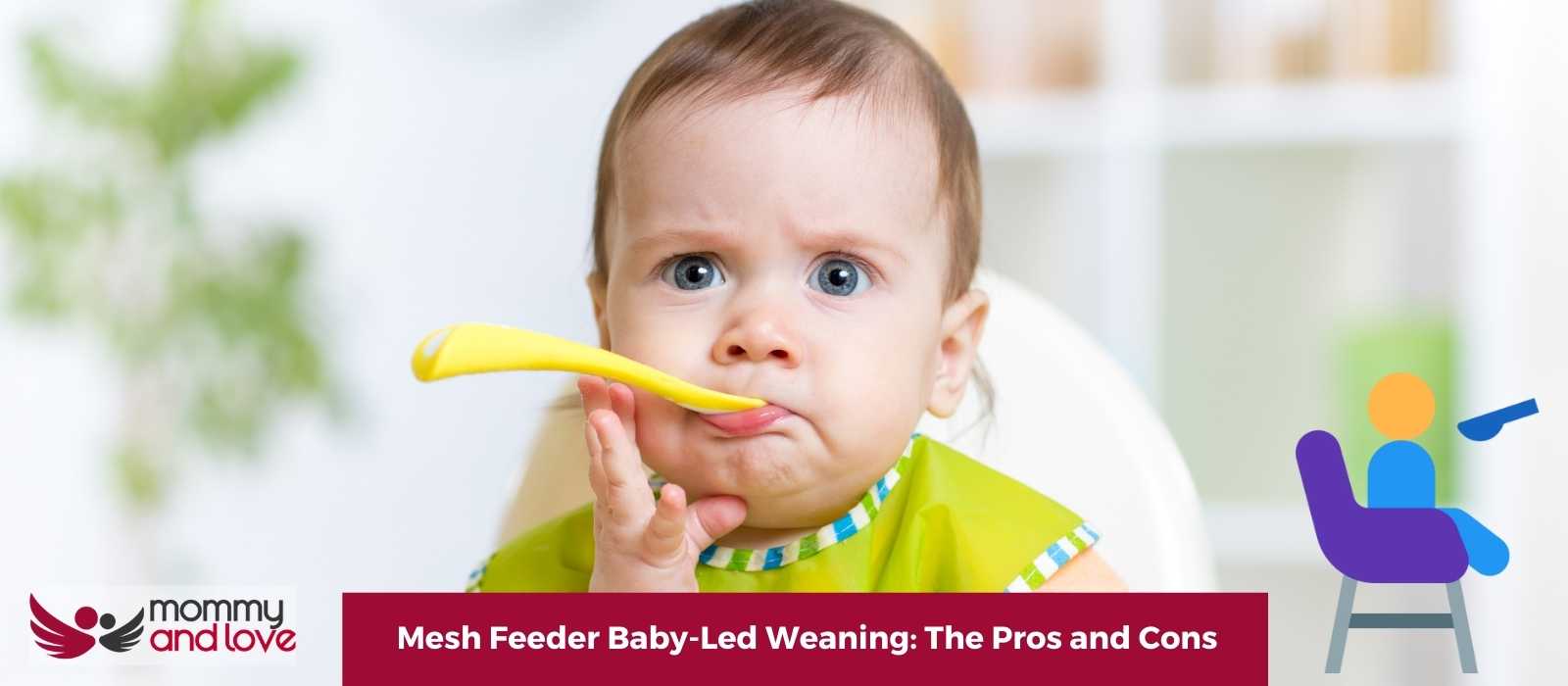Mesh feeders are a popular way to introduce solids for baby-led weaning. There are pros and cons to using a mesh baby feeder, and it is important to weigh all of the options before making a decision. In this blog post, we will discuss the benefits and drawbacks of baby food feeders for baby-led weaning.
What Are Mesh Feeders or Baby Feeders?
Baby food feeders are a fun and super easy way to introduce your kids to solid or whole foods and a great tool for feeding babies and toddlers. They’re a handy tool for parents who want to let their children experiment with different flavors and textures while keeping them safe from choking.
A mesh feeder is a plastic or silicone sac that holds fruit, vegetables and other healthy snacks. The sac has tiny holes in it, so when you place food inside and close the container, only small pieces can get out.
This way, you can give your baby tiny bites of food without having to worry about choking hazards. There are plastic and silicone ones aside from mesh.
One of the most popular baby feeders is the Munchkin Fresh Food Feeder. It makes it possible for your little one to enjoy delicious soft foods without worrying you. And with its simple mesh design, small handle and small size, your kids can gnaw on new food safely.
Are Baby Feeders Good for Babies?
Mesh and silicone feeders are a great way to introduce your baby to new flavors. They provide hands-on experience with food in a safe, controlled way. It’s an ideal option for little kids who want to be in control of what they eat, and it gives them the opportunity to explore textures earlier than you might be able to introduce them when spoon-feeding.
Plus, it’s a fun activity for the baby!
The benefits of using baby food feeders can vary from child to child, but some of the most common include:
- Easier to clean than regular bottles. All you have to do is rinse them out with water and they are good as new.
- Come in a variety of sizes, so you can find one that is the perfect fit for your baby.
- Allow your baby to control how much food they eat at the beginning of meals. This helps them to develop a healthy appetite and teaches them how to eat properly.
- Great for infants who are starting to wean from breastfeeding or bottlefeeding. They can be used to introduce solid food into your baby’s diet.
- Can double as a toy while children get busy in their high chair during family meals.
- Super handy to soothe a teething baby.
- Affordable and can be found at most baby stores.
At What Age Can a Baby Use a Mesh Feeder?
Babies can start using a mesh or silicone feeder at around six months of age. This is the time when most of them are starting solids, in addition to breast milk or formula.
The mesh feeder’s design allows children to experience different textures of real food, while still being safe. The mesh is large enough that only small pieces get through, which prevents choking risk and other safety hazards from solids.
Baby feeders are also easy for parents to fill and clean. They are a great way for little ones to learn how to self-feed, as well as try new fresh or frozen food.
Do Baby Food Feeders for Babies Work for Easy Feeding?
Some infants seem to have an easier time using a mesh or silicone feeder. This is likely because they can see the food and it is easier for them to control how much they are taking in. If your child is having trouble with bottlefeeding, you may want to try a mesh baby feeder.
If you are breastfeeding, you can also use it to give your child some supplemental feeding. This can help them to gain weight and grow at a healthy rate.
If you are using a formula, you can also use a food feeder to make sure your child is getting the right amount of formula. This can help to reduce spit-up and gas.
How to Use a Baby Feeder
Almost all baby food feeders have similar designs so figuring out how to use them shouldn’t be a problem.
A baby food feeder can be a great way to introduce your little one to fresh or frozen foods. Even an older baby can use a feeder. It allows you to give them a healthy taste of fruits and veggies, while also letting them explore new tastes and textures.
To use a baby food feeder, you simply fill the mesh bag or silicone pouch with the desired food and tie the string and snap shut to keep it secure. Place the bag in your baby’s mouth and let him or her gnaw on the meal inside.
It’s important to remember that feeding time should still be a relatively slow process. While your little one is chewing, he or she may be able to suck some of the food through the mesh, but most will still need to be chewed.
There’s no rush! Enjoy this time with your child as he or she learns about new foods, textures, and flavors.
What Are the Drawbacks of Using Baby Food Feeders
Baby food feeders are not without drawbacks. It can be quite easy for baby food feeders to become contaminated, so it is important that parents thoroughly clean the feeder between each use. It is also important for parents to buy more than one baby food feeder at a time, in order to easily monitor usage and prevent contamination.
Parents should only put fresh food into the feeder each time they use it. It is best to avoid putting anything other than fruits or veggies into the feeders, as any form of meat or pasta cannot be processed by the baby and may cause choking, illness or diarrhea.
The types of fruit and veggies that can be put into a baby food feeder are usually limited. Items such as bananas and strawberries are soft enough to pass through the feeder without the seeds being visible, but items such as cherries, which have large pits, should not be used in the baby food feeder.
A baby feeder should never be left unattended with an infant or toddler. Although many companies claim that these devices are safe for all ages, it’s still possible for an infant or toddler to choke if left unsupervised.
For some babies, using a baby food feeder may take away their desire to eat by mouth which makes them a bad idea if you use them exclusively. The first step of learning to eat is the oral exploration of food. This exploration is important in the development of a child’s ability to chew and swallow.
In addition, eating is also a social activity that involves watching others around you eat and learning how to feed yourself from watching others as well. Learning to use a spoon and a fork involves hand-eye coordination and is an important developmental milestone that can be delayed when using a baby food feeder instead of feeding your child directly with a pre-loaded spoon.
How Can I Use a Baby Feeder to Help My Teething Baby?
A baby feeder can help soothe a teething baby by providing them with something to chew on. The feeder can be filled with either food, whole pieces of ice or ice cubes (or frozen breastmilk), which will help to numb the gums and relieve some of the pain. Be sure to monitor your baby closely while they are using the feeder, and always remove it when they are finished chewing.
What Baby Foods Can I Put Into a Baby Feeder?
You can put just about any kind of food into a baby feeder! Just be sure to cut it into small pieces so that your baby can chew and swallow it easily. Some good options include:
- Cut up your favorite fruits into small pieces and give them to your baby. Great idea for a snack for your little one and the whole family! Examples include frozen blueberries, cucumber, banana and cantaloupe.
- Try giving your baby some roasted, steamed or boiled veggies as a healthy snack. Good examples are roasted sweet potato and butternut squash.
- Soft, fresh bread is a great option for baby feeders. Just make sure to cut it into small pieces first.
- Protein-rich foods like cooked chicken or beef work well.
- Cheese is a great snack for babies, and it’s easy to cut into small pieces.
- Yogurt is a healthy and tasty snack for babies, and it’s easy to scoop into a feeder. Frozen milk is another good option.
You can use frozen fruit or soft, ripe fresh fruit. Avoid giving any fruits or vegetables that are very hard, as your little one may find this frustrating to chew.
Conclusion on Whether to Use Baby Feeders
Using a baby feeder can be a fun and easy way for your little one to start eating solid foods. Just be sure to monitor your little one closely while they are using the feeder, and always remove it when they are finished chewing.
You can put just about any type of food into a feeder, so have fun experimenting with different flavors and textures. And be sure to keep your feeder clean between uses!

This article was written by Sandra Baker – full time writer and the mother of four amazing kids (including twins!)
She’s also a breastfeeding counselor and has spent years helping new parents learn how to care for their children. When she’s not writing or caring for her children, Sandra likes to spend time reading and taking walks with her husband.





